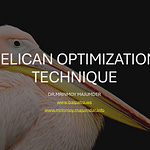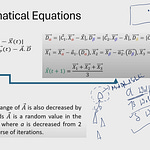For the best listening experience, use headphones at a volume between 70 and less than 80.
The Whale Optimization Algorithm (WOA) is a nature-inspired meta-heuristic optimization technique that mimics the bubble-net hunting strategy of humpback whales. Known for its simple design and competitive performance, WOA has been widely adopted and further developed for various engineering and real-world optimization problems.
Description of Whale Optimization Techniques
WOA models the social behavior of humpback whales using three main strategies:
Shrinking encircling: Whales encircle prey as the search narrows in on a promising solution.
Spiral updating: Whales perform a spiral-shaped movement to emulate bubble-net hunting behavior.
Random search: Diversification is introduced to avoid premature convergence by randomly searching the solution space.
Strengths
Simplicity: WOA is easy to understand and implement, owing to its straightforward mathematical model and low number of parameters.
Flexibility: Suitable for continuous and discrete, as well as unimodal and multimodal problems in various fields, with many successful applications and variants.
Competitive Performance: Demonstrates high-speed convergence and balanced exploitation-exploration dynamics, often outperforming similar algorithms or yielding competitive results on benchmark and real-world problems.
Weaknesses
Premature Convergence: Like many swarm-based techniques, standard WOA is at risk of becoming trapped in local optima, reducing solution diversity and performance for complex landscapes(Ref1 | Ref2).
Low Population Diversity: Limited exploration mechanisms can hinder the algorithm’s ability to discover new, promising areas, particularly in large or rugged search spaces(Ref1 | Ref2).
Slow Convergence in Complex Problems: WOA may exhibit slow progress or stagnation when addressing high-dimensional or very complex optimization tasks, which has motivated many hybrid and improved versions(Ref1 | Ref2).
Notable Applications
Engineering Design Optimization: Structural design, mechanical system optimization, and configuration tasks.
Parameter Estimation: Used in fields like geophysics, such as waveform inversion and tunnel velocity modeling.
Medical Imaging and Diagnostics: Feature selection, image classification, and bioinformatics.
Control System Tuning: Applied in PID controller parameter tuning and energy systems optimization.
Environmental Modeling: Used for air pollutant source localization, water resource management, and similar areas.
WOA’s adaptability and simplicity have spurred ongoing research, leading to numerous hybrid and enhanced variants that address its traditional limitations by integrating other algorithms, improved initialization, and novel search mechanisms.(Ref1 | Ref2)
Whenever you’re ready, here are three great ways you can support us:
Promote yourself or your organisation by sponsoring this newsletter — we reach an engaged audience with a 30–40% weekly open rate. Please leave a message or contact me directly at mrinmoy@majumdar.info.
Upgrade to a paid membership and unlock exclusive insights and benefits. Click here. (Click here to pay in USD)
Subscribe to the “AIDS in WRD” Podcast on YouTube and stay connected with the latest in the application of AI and DS in water resource research. Click here.
This tutorial is also available on my YouTube Channel: Click here.
Subscribe to my YouTube Channel or become a paid member of Baipatra VSC Newsletters to receive the remaining tutorials.
Contribute to this newsletter.
You may also like :
1)Explore Lenovo(AD)
4)International Journal of HydroClimatic Engineering: Call for Paper
5)Virtual Forum on Water and Power Engineering: Call for Paper
7)Bio Inspired Optimization Technique Bundle Membership
8)How to open your own home page?(AD)
9)Podcast : Hydrology for Beginners









